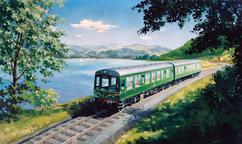





Drawing, pencil on paper, portrait of an Indian servant named Tiarmarree, by J Bradden, 28th December 1856. Depicts a man in Indian dress, stood square on with his hands at his side, from the calves upwards. At bottom left is the inscription "Tiarmarree, Dec- 28th 1856" and at bottom right "Francis, 'Good curry mem!'" and "J Bradden (?) fecit". On the reverse is the inscription "Mr Gilbert Hicky's Khansamah Madrasee". Khansamah is an Urdu word for house steward or cook in charge of a kitchen. Madras (now Chennai) is a city in south India. Unframed, with the bottom left corner cut off. From the collection of George Turnbull, Chief Engineer of the East Indian Railway. The inscriptions on the obverse are in Turnbull’s hand.
The ‘Mr Gilbert Hicky’ referred to in the inscription is likely to be W. R. Gilbert Hickey, a British civil engineer who was active in Calcutta (now Kolkata) up until his death in 1872. He is known for reviving the Oriental Sporting Magazine in 1865 and for publishing several engineering texts on the use of hydrogen gas for lighting as well as the process of dry distillation.
The message on the front of the portrait is addressed to ‘Francis’. The use of the forename suggests Turnbull was close to the recipient. It may have been Dr Francis Turnbull, George Turnbull’s second cousin. Francis worked in several parts of India and was for a time the civil surgeon at Arrah in north-east India. He also treated East Indian Railway employees working on the Soane district, where the line crossed the Sone River. Perhaps the inscription recalls a meal that Francis and George Turnbull ate at W. R. Gilbert Hickey’s residence. ‘Mem’ is a variant of ma’am that was common in nineteenth-century India.
Nothing is currently known of the artist J. Bradden. Edward Braddon (1829¬-1904) served as an Assistant Engineer on the East Indian Railway and is known to have made at least one drawing of Indian people employed on the railway (see Wellcome Collection number 36614i). It is possible that Turnbull’s inscription actually reads ‘Braddon’ and that he made a mistake with Braddon’s forename initial.
Scottish engineer George Turnbull (1809-1889) oversaw the creation of one of the first railways in India, the East Indian Railway (EIR). The EIR ran from near Calcutta (now Kolkata), an East India Company trading post in the north-east that the Company established as the capital from 1773. The terminus was originally Benares (now Varanasi), but the line quickly extended to New Delhi in the north, which became the capital of India in 1911. Calcutta and New Delhi are over 1,300km miles from each other – further than the distance between Paris, France and Budapest, Hungary.
Turnbull collected artworks during his time in India, many of which were produced by EIR engineers. These watercolours and drawings provide a rare view of nineteenth-century India from the perspective of the British engineers designing and building the country’s first railways. The collection includes landscape scenes and portraits. While many of the landscapes show the construction of the railway, others focus entirely on India’s local architecture or its rural spaces. The portraits are of people Turnbull encountered while in India. While the portraits of British people are inscribed with their names, most of the Indian people depicted remain anonymous or identified only by their job.
The British introduced railways in India to satisfy the mounting economic and military needs of their colonial administration. They hoped that the new technology would foster an increased sense of collective identity by making it easier to travel quickly between distant regions. They also hoped the railways would socially ‘improve India’ by instilling a sense of punctuality among Indians, a quality British colonialists believed Indians lacked. The racist stereotypes underpinning these intentions, and the interconnected idea that technology could trigger social change, were common beliefs in nineteenth-century British society.
Details
- Category:
- Pictorial Collection (Railway)
- Object Number:
- 2017-7097
- Materials:
- paper (fibre product) and graphite
- type:
- drawing, pencil




